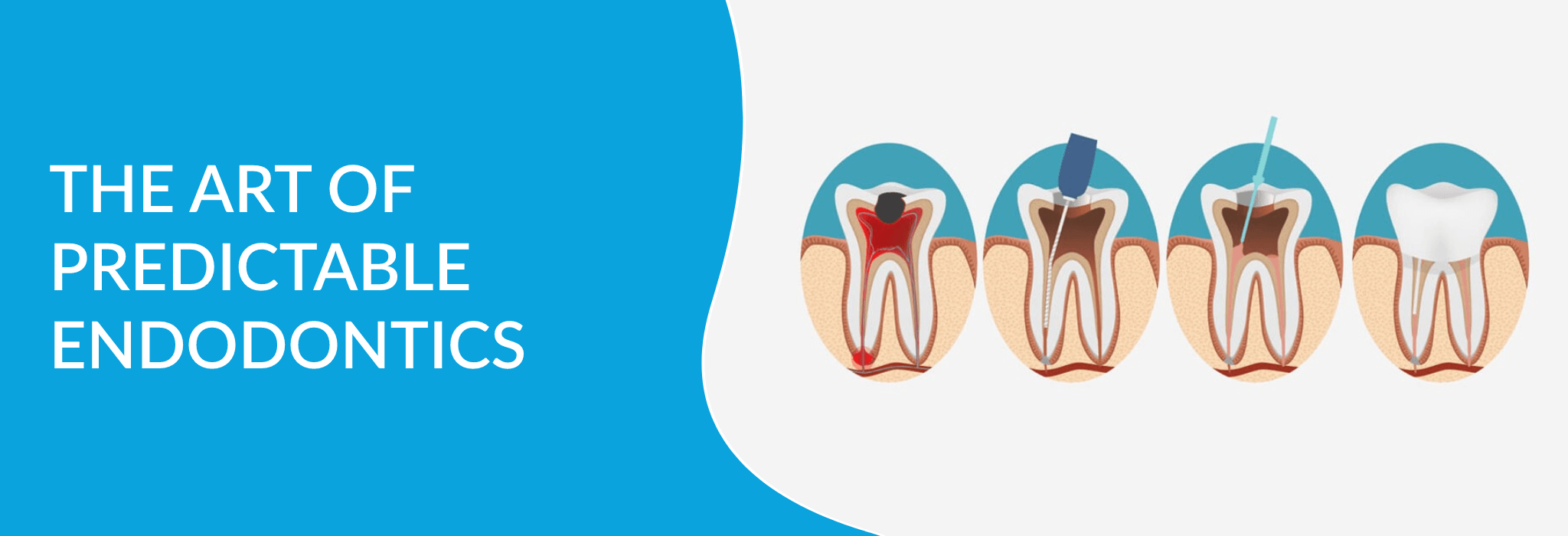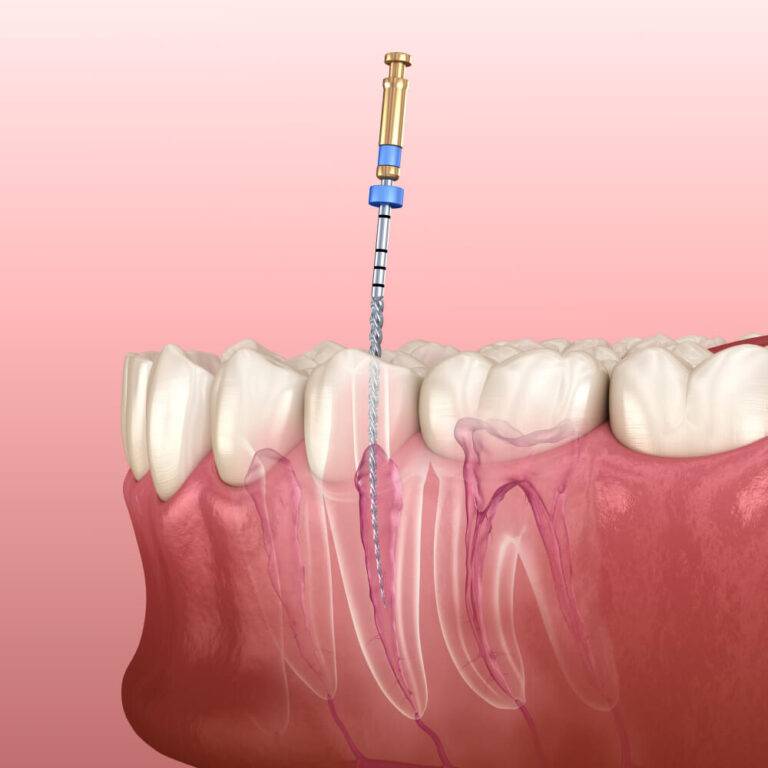
Endodontics Made Simple
What Defines A Successful Root Canal Treatment?

1) Pre-Operative Radiographic Assessment:
- Distance between coronal structure and
- Distance between caries and
- Distance between caries and
- Curvatures in
- Width of the
- Calcifications in
- Calcifications in root
- Width of the Check for open apex.
- Presence of root caries or sub gingival
- Presence or absence of periapical abscess/cyst/granuloma.

2) Communication With The Patient:
Once a proper diagnosis and treatment plan is decided, talk to the patient and discuss the following:
- Discuss about the prognosis of Be very honest about the chances of its success or survival.
- Inform the patient beforehand that in spite of giving local anesthesia, there might be mild to moderate pain or discomfort during the procedure. In such events ask them not to panic, shot or cry. They can raise their left hand to inform the
- Tell the patient that there are no guarantees in root canal treatments and sometimes in spite of taking all the efforts, the treatment may fail either in short term or in the long

3) Anaesthetizing The Tooth:
- Every root canal treatment has to be started under local anesthesia. Irrespective of whether the tooth is vital or non-vital, symptomatic or asymptomatic, it has to be anaesthetized completely.
- Use a topical anesthetic gel or spray at the injection site before inserting the needle to minimize the pain or
- Give nerve block and not local infiltration.
- The anaesthetic should be deposited as slow as possible. This helps in proper dispersion of anesthesia and is also less traumatic for the
- In cases where nerve block is not effective, bend the needle and give intra ligamentry injection around the This is very effective in controlling pain.
- If the patient still experiences pain after access opening, intra pulpal deposition of LA can be done. But remember it has to be done under pressure by placing a finger above the
4) Maintaining Aseptic Conditions:
- What I have learnt over the years is that the success or failure of any root canal treatment is predominantly decided by the presence or absence of microorganisms. Make sure of the following:
All the operative instruments, files, airotor, burs, endomotor and everything that is being used in the treatment is thoroughly
- Isolation of the highest standard.
- Saliva and blood contain a large amount of microorganisms and therefore isolation the tooth that is being treated is mandatory. Applying a rubber dam is the best option. In cases where there is no rubber dam, high volume suction with cotton rolls on each side of the tooth can help to a certain extent. Remember- some isolation is better than no isolation.
- Rebuilding the missing walls:
- This helps in preventing the outer microorganisms to enter in the tooth and also in holding the irrigant in the tooth chamber
5) Access Opening:
Use airotor with LED Improved visualization increases ease and decreases effort.
- Removal of caries is mandatory. This eliminates the microorganisms and also increases visibility. Try extending the carious part into the pulp chamber (caries driven access).
- In ideal cases or cases where tooth is used as abudtment, always start from the center (law of centrality).
- Try to locate the largest and the widest canal For example, palatal canal in maxillary molar and distal canal in mandibular molar.
- Based on radiographic assessment, make a slow guided approach with the help of a round bur till a drop in is
- Once a drop in is felt, extend it towards other canals without going any further This can be made easy by using a bur with non-cutting tip (endo Z bur).
- At any instance when there is difficulty in locating canals, the following methods can be tried:
- Take a radiograph and analyze how far the cavity is from the pulp
- Clean the cavity using sodium hypochlorite and then dry it with a cotton This removes the debris and enhances visibility.
- Take a picture of the access cavity using intra oral camera. This gives us a magnified image of the cavity on the
6) Determining the working length:
For a long time, I relied on my tactile sensation and avoided this step. The logic behind it being that I would verify it with my master cone radiograph just before the obturation. I was negligent here and it took me time to realize that:
- Working on a short working length will end up in pulpal tissue and bacteria in the apical portion of tooth. And by the time we realize this in the pre obturation radiograph, we have to repeat the entire bmp from the beginning with the correct working This wastes a lot of time for the operator as well for the patient.
- Working on a larger than required working length causes pain to the patient and violates the apex. Continuous filing beyond the canal is the major reason for mid treatment flare
Common methods of determining the working length are:
- Taking a radiograph (Ingles method)
- Using a good quality apex locator (make sure the canals are dried to avoid any false reading)
- Paper points also help in getting an idea about working length. Bleeding or moisture at the end of the paper point indicate going beyond the
7) Cleaning And Shaping Of The Canal:
a) Initial file:
The ideal initial file is 10k for any case. This file helps to create a glide path.
b) Pre curving the file:
Pre curving the apical part of the file before placing it in the canals helps us to explore the curvatures and respect the natural anatomy of the tooth.
c) Hand filing:
Whatever be the file system, hand filing upto minimum 20k helps to loosen up the canal and prevent stress on the root canals and also on the upcoming rotary files.
d) Orifice opening:
This step is very underestimated. Using an orifice opener to open the coronal 2/3rd of the canal decreases strain on the rotary files. The enlarged orifices appear dark in color and aid in easy location of canals during bio mechanical preparation.
e) Filing motions:
- The rotary files should never be forced apically in the canal. The motion has to be passive. Forceful filing will push the debris in the periapical area causing mid treatment flare
- Scrape the walls of the root canals with the
- All files should be coated with EDTA preparations. This will facilitate smooth movement of the files. When the EDTA comes in contact with the walls of root canals, it causes chelation and helps in removing debris.
f) Apical diameter:
- There is no fixed concept as to what size the apical diameter has to be This depends on various factors.
- Never violate the apical This will lead to loss of working length and also open the communication between apex and periapical area.
g) Golden rule:
If access opening is being done, then BMP has to be done on the same visit. Atleast till a minimum hand filing of 25k. Avoid using formocresol. This will relieve the patient from pain and in most cases it will avoid the necessity of local anaesthesia on the second visit.
8) Irrigation:
Never compromise on irrigation. Copious irrigation should be done after each filing.
a) Choice Of Irrigant:
After experimenting with a lot of irrigants, I have realized that no irrigant is as good as sodium hypochlorite. NaOCl has tissue dissolving properties and also has a mild anti-bacterial effect. A great endodontist once said,” Doing RCT without sodium hypochlorite is like trying to cut vegetables with a
spoon”.
If a rubber dam is applied, then full concentration NaOCl (>6%) should be used.
In cases without rubber dam, 3% NaOCl should be used with cotton rolls on each side on the tooth and a high volume suction placed close to the tooth. The cotton rolls should be removed immediately after irrigation to avoid prolonged contact of hypo with the soft tissues.
Chlorhexidine irrigant (2%) can be used in infected cases as it has strong anti- microbial
In calcified canals and blocked chambers, EDTA irrigant (17%) will help in chelation and make our work
Saline is a good irrigant to wash out the debris. It is mild and non-toxic but it does not have any anti-microbial effect. It can be used as an adjunct with other irrigants.
a) Method Of Irrigation
Insert the irrigation needle 4-5mm away from the apex. The needle should never bind to the walls of the
Irrigation should never be forced into the canal. The deposition of irrigant has to be slow and
Use side vent needles. Irrigation with side vent needles prevents the flow of irrigants beyond the
Avoid using NaOCl, EDTA or CHX in the same tooth. This will cause a reaction and end up in formation of
Let the irrigants stay in the canal for some Studies have shown that NaOCl requires at least 20 minutes to dissolve pulp tissue.
Activation of irrigants can enhance the treatment success to a great extent. This helps in facilitating the flow of irrigants to all those places where our files cannot reach
9) Obturating The Canals:
a) Drying the canals with paper points:
This is yet another step which is very underestimated and skipped by many practitioners. Drying the canals is mandatory to achieve good bonding of obturating material and canals.
b) Common obturation techniques:
There are various obturation techniques and using any one of them would be fine. Honestly speaking, if the canals are cleaned well and dried properly, the technique of obturation does not have much impact on the success and failure of tooth.
I. Single cone technique:
This technique works fine for molars and upper premolars. Make sure the single cone fits tightly in the canal, especially at the apical third and is well coated with sealer.
Palatal canal in maxillary molars and distal canal in mandibular molars have to be cross checked and if needed lateral gutta percha cones should be compacted.
II. Lateral compaction technique:
Ideal technique for anterior teeth and lower premolars with single canals. Try to achieve three dimensional obturation with fluid tight seal (no lateral spaces).
III. Down pack and back fill technique:
Another great and easy technique which can be used in all teeth. However, it requires specific obturating armamentarium which is not available in all dental set ups.
c) Sealing the gutta percha:
It is very important to seal the gutta percha exactly at the orifice of canals. Make sure there is no remanant gutta percha in the coronal cavity as it may affect the placement of permanent restoration.
It is best to seal one canal at a time and not altogether.
d) Cleaning the cavity after irrigation:
Clean the cavity with either saline or isopropyl alcohol and dry it properly with cotton pellet. Any contamination in the cavity with affect the permanent restoration.
e) Sealer puff:
Not desirable. Neither harmful.
It may cause temporary post-operative pain which can be controlled by medications. It is important to understand the difference between sealer puff, sealer extrusion and over filling.
f) Under and over obturation:
As long as the bio mechanical preparation is done properly and the canals are clean and sterile, a little short or a little over obturation is fine and wont effect the outcome of the treatment.
Anything in excess is not acceptable and if it happens then the obturation should be repeated.
10) Mandatory radiographs in RCT:
- Pre-op radiograph
- Working length radiograph
- Mater cone radiograph
- Pot-op radiograph
11) Communication With The Patient After The Treatment:
The following instructions should be given to the patient after the treatment:
- Post- operative tenderness e. pain on mastication is common in root canal treated teeth for a few days (3-7 days). This is normal and can be controlled by medication.
- Avoid biting on anything hard: Ask the patients to avoid hard foods such as bones, nuts, guava etc. as these may fracture the treated tooth. Patients have to be very careful at least till they get a crown.
- Ask the patients to come back for follow up evaluation of the treated teeth every 3 This is particularly very important in cases with periapical lesions.
12) Documentation of cases:
- All the data of the case should be kept with the doctor and stored permanently. This includes:
- Patient details
- Medical history of the patient
- Chief complaint of the patient
- Advised treatment plan
- Treatment done
- All the radiographs


